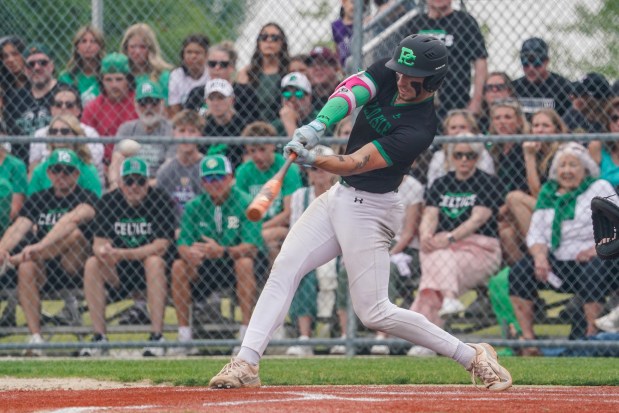Amid persistent staffing shortages, East Aurora School District 131 has taken several new measures to recruit teachers over the past few years.
Last year, the district began partnering with Aurora University to help individuals — including current employees of the district — earn college credit or teaching licenses to fill high-demand positions, said the district’s Associate Superintendent of Staff and Student Services David Ballard. The district is currently working on a similar partnership with Northern Illinois University.
The district also provides stipends to bilingual teachers and staff who relocate to the Aurora school district, and it also has a teacher mentor program that it hopes will help attract candidates for open positions.
These programs are meant to help fill staff openings, particularly in areas the district struggles to recruit enough staff for — special education, bilingual education and paraprofessional staff, to name a few.
Staffing shortages are by no means unique to East Aurora, however. In fact, the recruitment programs the district has instituted are funded by an initiative — the Illinois State Board of Education’s Teacher Vacancy Grant program — that is meant to address staffing challenges in school districts statewide.
The state initiative, which began as a pilot for the 2023-24 school year, provided funding to 170 of the state’s most understaffed school districts, East Aurora included. Now in its second year, the program received $45 million from the state to distribute to school districts.
Results so far show that 51% of districts receiving this grant funding saw a decrease in unfilled positions, compared to only 17% of districts who didn’t, according to a news release from the Illinois State Board of Education last fall.
While these initiatives are fairly new, the issue they’re meant to address has been around since the COVID-19 pandemic, the state’s organization of regional superintendents has previously said. The Illinois Association of Regional Superintendents of Schools, or IARSS, has said schools statewide are struggling to recruit qualified teachers, and seeing teachers retiring earlier than expected due to stress.
The state has attempted various strategies in recent years, such as increasing the minimum pay for teachers and the vacancy grant program.
This year, the problem appears to be easing slightly. The number of unfilled teaching positions in the state, for example, dropped from 4,096 during the 2023-24 year to 3,864 this school year, according to this year’s report, which uses data collected by the Illinois State Board of Education and the Illinois Association of Regional Superintendents of Schools.
Of the Aurora-area school districts, East Aurora had by far the highest teacher vacancy rate with 39 open teaching positions, according to this year’s data from ISBE and IARSS. Nearby West Aurora School District 129 had 12 unfilled teaching positions, while Indian Prairie School District 204 reported the equivalent of 2.3 vacant positions.
The state dashboard’s data on the number of positions is self-reported from the school districts, said Meg Bates, the director of the Illinois Workforce and Education Research Collaborative. Bates’ research group is housed at the University of Illinois system and collaborated with the Illinois State Board of Education on the data collection for its educator shortage dashboard.
Unfilled positions are as of Oct. 1, 2024 — and could fluctuate over the course of the year — and vacancy rates are determined by comparing the number of filled positions from last year’s data with the number of unfilled positions this year.
East Aurora’s teacher vacancy rate is “very high,” according to Bates, noting the disparity in openings between it and the districts surrounding it.
And some content areas and specializations have more vacancies than others.
For example, special education is one area where all three districts in the area are struggling to fill positions. East Aurora had 11 vacancies — a more than 12% vacancy rate — while West Aurora had five vacancies and Indian Prairie had 1.5, according to this year’s data from ISBE and IARSS.
As for non-teacher positions, all three districts are facing paraprofessional shortages, according to this year’s data. Indian Prairie had the most openings at 53.10, while East had 22 and West had 14.30.
Paraprofessional and substitute teacher shortages also bring their share of challenges on districts, said Indian Prairie fifth-grade teacher and 2024 Illinois Teacher of the Year Rachael Mahmood. Without enough of either, teachers and paraprofessionals in the schools have to adapt and pick up the slack.
“It’s not restructuring that goes on for an entire year,” Mahmood said. “It’s restructuring that goes on every single morning.”
She said that makes it difficult for teachers to balance taking off work when they need to, given these challenges and the strain their absence puts on their students and fellow teachers.
In East Aurora, overall vacancies — inclusive of vacancies for teachers, paraprofessionals, school counselors, etc. — went up slightly in recent years, from 67 in 2023 to 71 in 2025, according to data from the Illinois State Board of Education. During those years, the number of paraprofessional openings has gone down but is still the highest share of unfilled positions in the district. The rest were primarily teaching roles across various subject areas.
In the past year, East Aurora has hired 249 staff members, according to Ballard. In April, East Aurora’s school board authorized another 14 staffing requests for next year: three special education teachers, two bilingual teachers, several teachers in other subject areas and three social workers.
But hiring full-time staff has not been able to fill the gap completely for East Aurora, as is the case at many schools across the state. Often, the method by which vacancies are filled in school districts is through alternative measures.
Relative to its neighboring districts, this has been a significant portion of how East Aurora has dealt with its staffing challenges — the district ‘remedied’ more teacher and support staff positions, 403 in total, than any other district in the state, per data from the 2024-25 report. West Aurora remedied the equivalent of 13 staff positions, and Indian Prairie remedied six.
“They have to do something,” Bates said about East Aurora. “And they have a really chronic issue.”
Ballard said that typically looks like hiring long-term substitute teachers, offering paid extra duty assignments for existing staff and paying for contractual staff. A number of them simply remained unfilled and unremedied.
Filling positions this way is not the district’s preference, he said, but sometimes it’s the only option.
“We may have an emergency where there’s a student who needs a one-to-one (teaching assistant), perhaps,” Ballard told The Beacon-News recently. Speech language pathologists, for example, are often difficult to fill with district employees, he said.
While concerns about a teacher shortage increased in recent years, concerns about staffing preceded the COVID-19 pandemic, Bates said. But she noted that it’s not equally felt across the state: the bulk of the shortage is concentrated in some content areas and a limited number of districts.
A 2023 report from the education watchdog group Advance Illinois found that a vast number of vacancies are in special education and bilingual education, and it’s a more prevalent issue in rural and low-income districts — a disparity state initiatives have sought to address.
Last summer, the Illinois State Board of Education launched a bilingual recruitment campaign, with a particular emphasis on roles like special education and bilingual education instructors that targeted both urban and rural areas, to attempt to fill the gaps.
The initiative attracted more than 17,000 individuals interested in becoming a teacher, according to a press release from the Illinois State Board of Education on March 17. The program’s advertising was paid for with one-time federal pandemic relief money, and though advertising ended in January, the state’s BecomeATeacher.com website will remain live going forward.
Bates said that, from a policy perspective, it’s important not to take a “broad-brush” approach and instead to concentrate state resources and support on the districts and content areas that need it most. That’s the rationale for programs like the Teacher Vacancy Grants, she explained. East Aurora is a recipient of a Teacher Vacancy Grant, for example, while neighboring Indian Prairie and West Aurora are not.
And reasons for higher vacancy rates in different — sometimes neighboring — school districts are varied, Bates said, often coming down to factors like the income-level of students’ families, which she said often correlates with performance on standardized tests, and sometimes with decreased funding for the district resulting from a lower property tax base.
East Aurora has around 70% low-income students, according to state data from 2023-24, whereas West Aurora was 50% low-income and Indian Prairie was at 21%.
“A lot of it is perception,” Bates said in an interview in early April about districts with high low-income populations. “It’s perceived as a more challenging environment to work in.”
While rural areas tend to struggle with attracting teachers willing to move, she said, urban school districts tend to face the issue of competition among nearby districts for teachers.
Bates said what East Aurora “is facing is its proximity” to West Aurora and Indian Prairie.
“It might just be, you know, teachers work and they start their career (in East Aurora) and then they’re looking at Indian Prairie and thinking, I could make 10K more,” Bates said.
Now, as concerns about possible Trump administration federal funding cuts to education swirl, school districts face new uncertainties.
The Teacher Vacancy Grants are funded by state dollars, meaning they wouldn’t be affected by possible federal funding interruptions or losses, an ISBE spokesperson told The Beacon-News previously. Some federal funding is doled out based on the number of low-income students, however, so a district like East Aurora might be harder hit by a potential loss of federal education dollars, Bates noted. Those impacts are not specific to hiring, but would likely tighten budgets in the districts reliant on that funding source.
But, while uncertainty remains, local districts are doing what they can to fill positions and stay afloat.
Indian Prairie said holding teaching assistant job fairs has helped fill significant gaps in support staff, namely special education paraprofessionals, according to a district spokesperson.

The district also has what it calls the “Grow Your Own Teachers” program, a joint effort between the district and teachers union started in 2021, according to past reporting. Through student clubs, social media campaigns and information and career fairs, the program is meant to encourage students to consider pursuing a career in education — and to return to Indian Prairie to do it.
A spokesperson for West Aurora said that the district is “currently well-staffed,” but, still, they’ve made new marketing materials and brought current teachers to job fairs and hiring events to talk about their experiences in the district. Like East Aurora, they also pointed to their two-year induction and mentoring program for new teachers as a key retention strategy.
And much of East’s focus is on widening the applicant pool, Ballard said, such as its initiatives meant to help individuals get licensed to fill in-demand roles.
“While we try a number of tried-and-true tactics that everybody else does — job fairs, and those kinds of things, student teachers, those kind of personal connections — we also want to explore ways that we’re trying to reach out in a proactive way,” Ballard said. “We know that we’ve got to expand our reach … recruiting, retention is really a full-time thing.”
Mahmood said statewide and district programs can address some of the major issues school districts have with attracting teachers, like improving pay. But there are other, non-monetary factors for what makes a teacher come to or stay at their school.
“I believe that a person who feels belonging in their district or school … is going to want to stay, even if it’s not the highest pay,” Mahmood said.
Belonging has been a key theme of the work she is doing during her year-long sabbatical to advance the profession of teaching, she said.
“There’s something in your heart that makes you feel connected in a way that fills a piece of you that you need filled.” she said.
And that in itself is a long-term recruitment strategy, she said.
“If teachers were so validated and affirmed in the work they did, and they poured all of that onto kids, and kids saw teachers having, like, the time of their life in the classrooms, and classrooms were so much fun, and all these things were going on, they’d be like, ‘Man, I’d love to have a career like this,’” Mahmood said. “We have 12 years of advertisement for our career.”
mmorrow@chicagotribune.com





